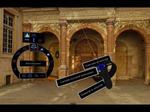Other

“Through an imaginative experiment, researchers were able to get two extremely different animal species located far apart to interact with each other and reach a shared decision with the help of robots. Bees and fish don’t often have the …

“Researchers at EPFL have developed a simple mid-infrared laser source that can be used to detect pollution in the air or molecules in someone’s breath. Their system takes up considerably less space than the large ones typically used for …

“Physicists at EPFL propose a new “quantum simulator”: a laser-based device that can be used to study a wide range of quantum systems. Studying it, the researchers have found that photons can behave like magnetic dipoles at temperatures close to …

“EPFL researchers have developed a compact and efficient medium-frequency transformer. Their device is poised to enhance the flexibility and efficiency of tomorrow’s smart grids and DC power distribution networks. An EPFL-made prototype has been thoroughly tested and presented …

“EPFL researchers have found a way to control and standardize the production of nanowires on silicon surfaces. This discovery could make it possible to grow nanowires on electronic platforms, with potential applications including the integration of nanolasers into electronic chips …

“EPFL scientists have developed microscopic, hydrogel-based muscles that can manipulate and mechanically stimulate biological tissue. These soft, biocompatible robots could be used for targeted therapy and to help diagnose and prevent disease. Human tissues experience a variety of mechanical stimuli …

“Scientists from EPFL and the Russian Quantum Center have built a photonic integrated, compact, and portable soliton microcomb source. The device is less than 1 cm3 in size, and is driven by an on-chip indium phosphide laser consuming less than …

“Scientists at EPFL and ETH Zurich have developed tiny elastic robots that can change shape depending on their surroundings. Modeled after bacteria and fully biocompatible, these robots optimize their movements so as to get to hard-to-reach areas of the human …

“A small lab-grown diamond measuring a few millimeters per side could one day enable civilian drones to be recharged in mid-flight through a laser. Thanks to the diamond, the laser beam can remain strong enough over a long distance to …

“Wearing a virtual reality headset and using manual controllers, you can use Imverse’s new software to select tools that let you bring depth, cut, paste, paint and zoom in and out – much like in a photo editor. Your virtual …
